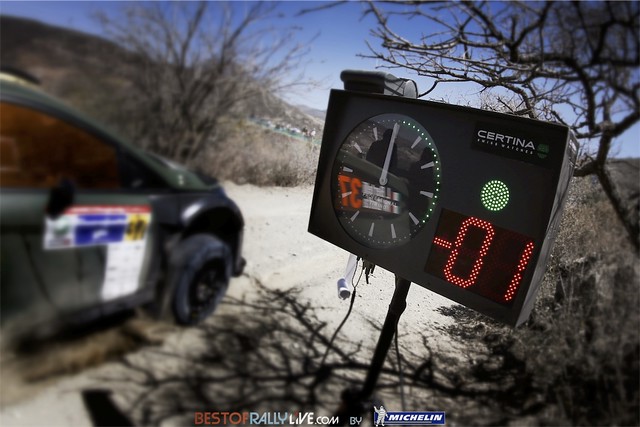Le Rallye d’Argentine a souvent été gagné d’un souffle : pour 2.4 secondes en 1999 et 2011, pour 4 secondes en 2002, pour 6 secondes en 1994… Qu’en sera-t-il cette année ?
Il y a 20 ans, Didier Auriol (Toyota Celica GT Four/Michelin) avait battu Carlos Sainz (Subaru Impreza 555) pour 6 secondes. Ce fut longtemps un des plus petits écarts enregistrés à l’arrivée d’un rallye mondial, derrière le Sanremo 1976 (4s entre Waldegard et Munari), le Sanremo 1989 (5s entre Biasion et Fiorio), et idem le Monte-Carlo 1979 avec 6s entre Darniche et Waldegard.
« On était ex aequo au départ de la dernière spéciale », se souvient Bernard Occelli, copilote de Didier Auriol. « Didier m’a dit : j’ai horreur de finir 2e. » Je lui ai répondu : moi aussi ! C’était assez chaud, mais c’est passé. A l’arrivée, on attendu Carlos, il faisait la gueule, on a vite compris. »
En 1999, l’arrivée du Rallye d’Argentine fut mouvementée entre deux pilotes Subaru séparés par 2s4. Le placide Juha Kankkunen fut déclaré vainqueur après avoir superbement ignoré les consignes du boss David Richards, devant le Britannique Richard Burns, furax, qui croyait avoir gagné rallye jusqu’à la dernière spéciale à Santa Rosa de Calamuchita… Ambiance sur le podium !
Le même écart de 2s4 a été enregistré à l’arrivée de l’édition 2011 entre Sébastien Loeb et Mikko Hirvonen, une fin de course qui restera elle-aussi dans les annales du championnat. Leader, Sébastien Ogier est parti en tonneau à deux spéciales du but et s’est retrouvé sans direction assistée. Au départ de la dernière ES, Loeb et Hirvonen étaient à 3s3 et 5s7 d’Ogier. La victoire est revenue à Sébastien Loeb pour 2s4 devant le Finlandais.
Le Rallye d’Argentine 2002 fut tout aussi « fou » ! Carlos Sainz (Ford Focus RS WRC) a été déclaré vainqueur dimanche soir, à 23h00 passées. Marcus Grönholm avait gagné le rallye sur le terrain, mais il fut mis hors course (assistance interdite). Deuxième, son équipier Richard Burns a récupéré la victoire durant quelques heures, avant d’être lui aussi mis hors-course (volant moteur non conforme). Et finalement, la bagarre pour la 3e place entre Sainz et Solberg, remportée par Carlos pour 4 secondes, était celle pour la victoire !
Rally Argentina has produced several photo-finishes over the years. The winning margin in 1999 and 2011 was 2.4 seconds, while the 1994 and 2002 events were won by six and four seconds respectively. Will the competition be as close this time round?

It was 20 years ago that Didier Auriol (Toyota Celica GT Four/Michelin) beat Carlos Sainz (Subaru Impreza 555) by six seconds. For a long time, that stood was one of the WRC’s smallest winning margins, beaten only by the 1976 Sanremo (a four-second gap between Waldegard and Munari) and the 1989 Sanremo (five seconds in it between Biasion and Fiorio). Meanwhile, it equalled the six-second gap between Darniche and Waldegard at the end of the 1979 Monte Carlo.
“We were level with Sainz going into the last stage,” recalls Auriol’s co-driver Bernard Occelli. “Didier said: ‘I hate coming second!’. I said: ‘me too!’. We took a lot of risks but we finished in once piece. We waited for Carlos at the end of the stage and we knew at once we had won by the expression on his face!”
The 1999 Rally Argentina ended with two Subaru drivers split by just 2.4s. The win went to Juha Kankkunen after he had calmly ignored team orders, while Richard Burns was furious because he believed the victory should have been his. The podium celebrations were somewhat subdued!
The outcome of the 2011 event was decided by the same gap after an unforgettable last-day shootout between Sébastien Loeb and Mikko Hirvonen. Sébastien Ogier had rolled while leading with two stages remaining and broken his power steering. At the start of the final test, Loeb and Hirvonen were 3.3s and 5.7s short of the Frenchman. The win ended up going to Loeb, 2.4s clear of the Finn.
The 2002 Rally Argentina produced an equally bizarre finish. The victory eventually went to Carlos Sainz (Ford Focus RS WRC) after Marcus Grönholm was disqualified for a servicing infringement. The Finn’s Peugeot team-mate Richard Burns figured at the top of the provisional leaderboard for a while after that, before he too was excluded (illegal flywheel). In the end, the exciting fight for third place between Sainz and Solberg turned out to be the battle for victory, which the Spaniard claimed by a margin of four seconds!

Aucun commentaire:
Enregistrer un commentaire